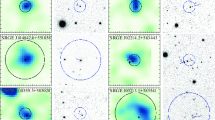Abstract
Based on observations with the transient double-beam spectrograph (TDS) at the 2.5-m telescope of the Caucasus Mountain Observatory of SAI MSU, we have determined the redshifts for 15 new quasars detected in X-rays by the eROSITA telescope of the SRG orbital observatory during the first three all-sky surveys. The redshifts of the sources lie in the range 0.5–4.156. We have estimated the masses of the central supermassive black holes and the bolometric luminosities for eight quasars from the width of the C IV 1549 Å emission line and the continuum flux at 1350 Å. For these objects we have also estimated the ratio of the X-ray luminosity to the Eddington limit to be a few percent. At the same time, the bolometric-to-Eddington luminosity ratio for them has turned out to be in a fairly narrow range, 30–40\({\%}\). A large \(L_{\textrm{bol}}/L_{\textrm{Edd}}\) ratio points to an active growth of the mass of the central black holes in these objects.







Similar content being viewed by others
REFERENCES
K. A. Arnaud, ASP Conf. Ser. 101, 17 (1996).
N. Ben Bekhti, L. Flöer, R. Keller, J. Kerp, D. Lenz, et al. (HI4PI Collab.), Astron. Astrophys. 594, A116 (2016).
I. F. Bikmaev, E. N. Irtuganov, E. A. Nikolaeva, N. A. Sakhibullin, R. I. Gumerov, A. S. Sklyanov, M. V. Glushkov, V. D. Borisov, R. A. Burenin, I. A. Zaznobin, R. A. Krivonos, A. R. Lyapin, P. S. Medvedev, A. V. Meshcheryakov, S. Yu. Sazonov, et al., Astron. Lett. 46, 645 (2020).
W. Cash, Astrophys. J. 228, 939 (1979).
Y. S. Dai, M. Elvis, J. Bergeron, G. G. Fazio, J.-S. Huang, B. J. Wilkes, et al., Astrophys. J. 791, 113 (2014).
A. V. Dodin, S. A. Potanin, N. I. Shatsky, A. A. Belinski, K. E. Atapin, M. A. Burlak, O. V. Egorov, A. M. Tatarnikov, K. A. Postnov, and M. I. Belvedersky, Astron. Lett. 46, 429 (2020).
K. Horne, Publ. Astron. Soc. Pacif. 98, 609 (1986).
G. A. Khorunzhev, S. Y. Sazonov, and R. A. Burenin, Astron. Lett. 44, 500 (2018).
G. A. Khorunzhev, A. V. Meshcheryakov, P. S. Medvedev, V. D. Borisov, R. A. Burenin, R. A. Krivonos, R. I. Uklein, E. S. Shablovinskaya, V. L. Afanasiev, S. N. Dodonov, R. A. Sunyaev, S. Yu. Sazonov, and M. R. Gilfanov, Astron. Lett. 47, 123 (2021).
V. Kornilov, B. Safonov, M. Kornilov, N. Shatsky, O. Voziakova, S. Potanin, et al., Publ. Astron. Soc. Pacif. 126, 482 (2014).
L. Marcotulli, V. Paliya, M. Ajello, A. Kaur, S. Marchesi, M. Rajagopal, et al., Astrophys. J. 889, 164 (2020).
A. V. Meshcheryakov, V. V. Glazkova, S. V. Gerasimov, and I. V. Mashechkin, Astron. Lett. 44, 735 (2018).
D. Park, J.-H. Woo, K. D. Denney, and J. Shin, Astrophys. J. 770, 87 (2013).
S. A. Potanin, A. A. Belinski, A. V. Dodin, S. G. Zheltoukhov, V. Y. Lander, K. A. Postnov, A. D. Savvin, A. M. Tatarnikov, A. M. Cherepashchuk, D. V. Cheryasov, I. V. Chilingarian, and N. I. Shatsky, Astron. Lett. 46, 836 (2020).
P. Predehl, R. Andritschke, V. Arefiev, V. Babyshkin, O. Batanov, W. Becker, et al., Astron. Astrophys. 647, A1 (2021).
N. Shatsky, A. Belinski, A. Dodin, S. Zheltoukhov, V. Kornilov, K. Postnov, et al., Ground-Based Astronomy in Russia. 21st Century, Ed. by I. I. Romanyuk, I. A. Yakunin, A. F. Valeev, and D. O. Kudryavtsev (2020), p. 127.
X. Shen, P. F. Hopkins, C.-A. Faucher-Giguère, D. M. Alexander, G. T. Richards, N. P. Ross, et al., Mon. Not. R. Astron. Soc. 495, 3252 (2020).
R. Sunyaev, V. Arefiev, V. Babyshkin, A. Bogomolov, K. Borisov, M. Buntov, et al., arXiv: 2104.13267 (2021).
E. L. Wright, Publ. Astron. Soc. Pacif. 118, 1711 (2006).
ACKNOWLEDGMENTS
This study is based on the observations with the eROSITA telescope onboard the SRG observatory. The SRG observatory was produced by Roscosmos in the interest of the Russian Academy of Sciences on behalf of the Space Research Institute within the Russian Federal Scientific Program with the participation of Deutsches Zentrum für Luft- und Raumfahrt (DLR). The SRG/eROSITA X-ray telescope was produced by a consortium of German institutes headed by Max-Planck-Institut für extraterrestrische Physik (MPE) under DLR support. The SRG spacecraft was designed, produced, launched, and is operated by the Lavochkin Research and Production Association and its subcontractors. The scientific data reception is performed by the system of deep space communication antennas in Medvezhi Ozera, Ussuriysk, and Baikonur and is financed by Roscosmos. The eROSITA data used in this paper were processed with the eSASS software developed by the German eROSITA consortium and the software developed by the Russian SRG/eROSITA consortium.
Funding
The search for candidates for distant quasars in the X-ray all-sky survey of the SRG orbital observatory and our analysis of the SRG/eROSITA data presented in this paper were supported by RSF grant no. 21-12-00343. The upgrade of the TDS at the 2.5-m CMO telescope was supported by the Ministry of Education and Science of the Russian Federation within the program of funding large scientific projects of the ‘‘Science’’ National Project (grant no. 075-15-2020-778). The observations at CMO SAI MSU were supported by the Leading Scientific–Educational School of the Moscow State University ‘‘Fundamental and Applied Space Research’’.
Author information
Authors and Affiliations
Corresponding author
Additional information
Translated by V. Astakhov
Rights and permissions
About this article
Cite this article
Dodin, A.V., Shatsky, N.I., Belinski, A.A. et al. Optical Spectroscopy of Quasars Discovered by SRG/eROSITA with a 2.5-m Telescope at the Caucasus Mountain Observatory of SAI MSU. Astron. Lett. 47, 661–673 (2021). https://doi.org/10.1134/S1063773721100029
Received:
Revised:
Accepted:
Published:
Issue Date:
DOI: https://doi.org/10.1134/S1063773721100029




